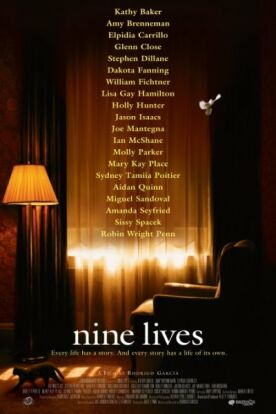Nine Lives
That I liked Rodrigo García’s Nine Lives I’m not afraid to admit, I think, even though it is a bit more arty and actorish than I generally care to sit still for. The film consists of nine vignettes, each featuring a different woman, some of them loosely linked by common subordinate characters and some standing alone, and each providing an opportunity for a talented actress really to show what she can do. For example, Sandra (Elpidia Carrillo), a middle-aged Hispanic woman, mops the floors of the LA County jail where she is an inmate and teeters on the brink of hysteria over her separation from her daughter. A young runaway (Lisa Gay Hamilton) who appears dangerously unbalanced comes home after years away to “work it out” with her estranged father. A middle aged woman (Kathy Baker) goes into hospital for a mastectomy and takes out her feelings of bitterness on her loving and attentive husband (Joe Mantegna).
The actresses are a mix of the well-known, like Sissy Spacek, Glenn Close, and Holly Hunter, and the unknown, at least to me, and the quality of the vignettes is as high among the one kind as the other. The problem is that, the better they are the more unsatisfied we tend to be with such a fleeting glimpse into lives that seem so interesting. Miss Hunter’s Sonia, for instance, in the fourth vignette is obviously in rather a peculiar relationship with Martin (Stephen Dillane), when their visit to relatively well-to-do friends Lisa (Molly Parker) and Damian (Jason Isaacs) brings out the appalling extent of the emotional carnage that has been going on between them. But if we see what should have torn them apart long ago, there isn’t really time for Mr García to go into what must surely be the much more interesting question of what it is that keeps them together in spite of it. “You’re a p**** to me sometimes,” says Sonia, doing no more than stating the obvious.
“I know,” says Martin rather anti-climactically.
What we need to know is not that Martin knows he’s being a p****. Obviously he does. What we need to know is why Sonia puts up with it.
Lisa and Damian are reduced to stunned and silent witnesses as Sonia and Martin tear each other apart, but both appear in other vignettes. Damian is the long-absent boyfriend of Diana (Robin Wright Penn) in the second vignette, which retrospectively seems to promise to slot into the fourth in some way but doesn’t. After five years apart with no contact, both Diana and Damian are married to other people, and Diana is heavily pregnant. Within five minutes of Damian’s running into her by accident in a supermarket, he is confessing that he is sterile and that, though he loves his wife, he has never been able to stop thinking about her, Diana. She, in turn, says: “Five minutes with you and I feel like my life is a figment of my imagination.”
But in the end does this additional information about Damian cast any light at all on his relationship with Lisa, or on their joint encounter with Sonia and Martin? It seems to cry out to do so, particularly as the immediate casus belli between the latter pair is an abortion hitherto almost undiscussed. Yet it remains an inert datum tucked away in Sonia and Martin’s little psychodrama. Lisa, likewise, apparently knowing nothing of Damian’s encounter with Diana, or perhaps even of her existence, reappears in the sixth vignette, in which Lorna (Amy Brenneman), with her parents, attends the funeral of the second wife of her ex-husband, Andrew (William Fichtner). We are given to understand that Lorna is not welcome there except by Andrew himself, who is deaf and who pines for her as Damian pines for Diana. In a feverishly signed dialogue between them, we learn that she remains susceptible to him as well, but not in a way suggesting poignancy and loss so much as selfishness and opportunism.
There is thus potentially a further dimension, though it remains no more than potential, to the brief dialogue between Lorna and Lisa when they meet in passing and Lisa makes a rather pointed answer to Lorna’s commonplace observation that it’s a small world. Sensing criticism, Lorna asks what she means. “I didn’t mean anything by it. It is a small world. We’re all moths around the same light bulb.” The same could be said of the film itself, in which the light bulb is love and mortality and the moths are beautiful and charming women trying to come to terms with loss. But it could only have been improved by the choice of some more social animal than the moth as its emblematic beast. For its structure as a series of discrete episodes forces the film to isolate the women from any meaningful social context. This, in turn, means that we are forced to see them as they see themselves — as we all see ourselves — namely, as the heroines of their own private melodramas.
The only two vignettes permitted to cast any real light on each other are numbers five and seven. In one, teenaged Samantha (Amanda Seyfried) declines a brilliant educational opportunity to stay at home with her crippled father (Aidan Quinn) and harried mother, Ruth (Miss Spacek), neither of whom can see that they are much more dependent on her than they think they are. But Ruth goes from being a supporting player in that one to the star of the show in the other, as her otherwise-seeming buttoned up and self-contained character contemplates an affair. Mostly, however, the artificial isolation of the characters produces just a hint of theatricality and self-pity that Mr García could well have done without. But it would be churlish not to be grateful for the many excellent things he has done with.
Discover more from James Bowman
Subscribe to get the latest posts to your email.







